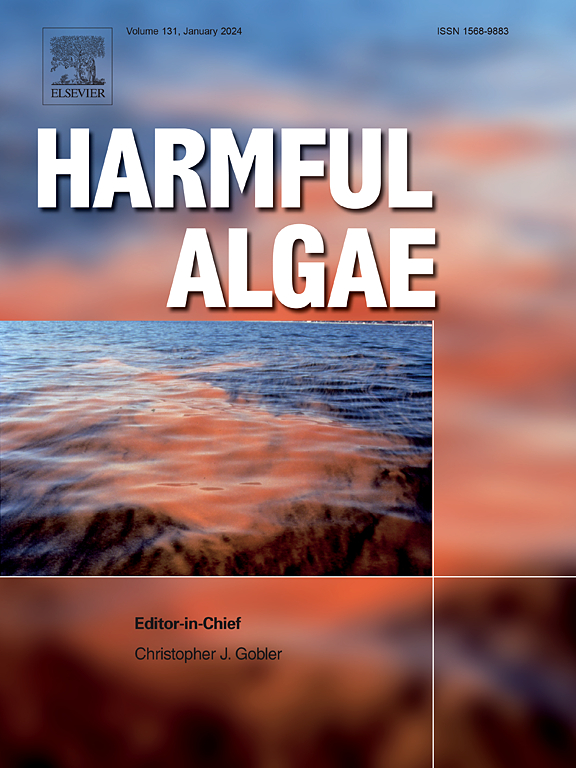Paralytic shellfish toxins and seabirds: evaluating sublethal effects, behavioral responses, and ecological implications of saxitoxin ingestion by common murres (Uria aalge)
IF 4.5
1区 生物学
Q1 MARINE & FRESHWATER BIOLOGY
引用次数: 0
Abstract
Paralytic shellfish toxins (PSTs), including saxitoxin (STX) and its congeners, are neurotoxins that can be produced during harmful algal blooms and cause illness or death in humans, fish, seabirds, and marine mammals. Since 2014, multiple large-scale seabird mortality events have occurred in Alaska waters, with STXs detected in some carcasses. To investigate the sublethal behavioral and ecological effects of STX on seabirds, we conducted captive dosing trials with common murres (Uria aalge). We gavaged purified STX (dehydrated STX dihydrocholoride, STX-diHCl) or an Alexandrium catenella culture extract into murres, monitored behavioral responses and recovery times, and assessed tissue concentrations in individuals that died or were euthanized. Using a modified up-and-down dose-finding scheme, we estimated a median effective dose (ED50) of 89 µg STX-equivalents (eq) kg-1 for STX-diHCl and 366 µg STX-eq kg-1 for the A. catenella extract based on ecologically relevant behavior. Differences between the ED50 estimates could reflect uncertainties in toxin equivalency factors for PST congeners, which are based on studies using purified toxins in mice and may vary across taxa or toxin matrices. Post-dosing concentrations of STX varied by tissue type across individuals, with quantifiable levels ranging from 3 to 379 µg STX-eq 100g-1. Evidence of biotransformation of STX in A. catenella extract-dosed birds was observed. We also measured the chronic effects of dosing with sublethal levels of STX-diHCl over seven-days, which resulted in lower fish intake among treatment birds compared to controls (-187 g day-1). This investigation improves our understanding of the ecological effects of PSTs on seabird health.
麻痹性贝类毒素和海鸟:评估普通海鸟摄入贝类毒素的亚致死效应、行为反应和生态影响(尿毒)
麻痹性贝类毒素(pst),包括蛤蚌毒素(STX)及其同系物,是在有害藻华期间产生的神经毒素,可导致人类、鱼类、海鸟和海洋哺乳动物的疾病或死亡。自2014年以来,阿拉斯加水域发生了多起大规模海鸟死亡事件,在一些尸体中发现了stx。为了研究STX对海鸟的亚致死行为和生态效应,我们对常见海鸟(乌里亚斑鹭)进行了圈养给药试验。我们将纯化的STX(脱水的STX二氢氯化物,STX- dihcl)或catenella亚历山大菌培养提取物灌胃到小鼠体内,监测行为反应和恢复时间,并评估死亡或安乐死个体的组织浓度。使用改进的上下剂量查找方案,基于生态相关行为,我们估计STX-diHCl的中位有效剂量(ED50)为89µg stx当量(eq) kg-1,而catenella提取物的中位有效剂量(ED50)为366µg stx当量kg-1。ED50估计值之间的差异可能反映了PST同系物毒素当量因子的不确定性,这是基于在小鼠中使用纯化毒素的研究,并且可能因分类群或毒素基质而异。STX给药后浓度因个体的组织类型而异,可量化水平为3至379µg STX-eq 100g-1。观察到STX生物转化的证据,在鸡链球菌提取物剂量的鸟类。我们还测量了在7天内给药亚致死水平的STX-diHCl的慢性效应,与对照组相比,治疗鸟的鱼摄入量减少(-187 g day-1)。本研究提高了我们对pst对海鸟健康的生态影响的认识。
本文章由计算机程序翻译,如有差异,请以英文原文为准。
求助全文
约1分钟内获得全文
求助全文
来源期刊

Harmful Algae
生物-海洋与淡水生物学
CiteScore
12.50
自引率
15.20%
发文量
122
审稿时长
7.5 months
期刊介绍:
This journal provides a forum to promote knowledge of harmful microalgae and macroalgae, including cyanobacteria, as well as monitoring, management and control of these organisms.
 求助内容:
求助内容: 应助结果提醒方式:
应助结果提醒方式:


